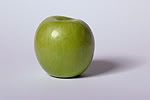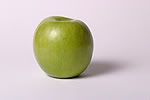 Standard reflector: All the light is reflected and sent towards the apple in a fairly direct manner. We see a pronounced shadow, as well as a clear highlight. The light falls off slightly towards the edges of the corner and the picture has a slightly blueish cast, suggesting that this particular standard reflector is not exactly neutral.
Standard reflector: All the light is reflected and sent towards the apple in a fairly direct manner. We see a pronounced shadow, as well as a clear highlight. The light falls off slightly towards the edges of the corner and the picture has a slightly blueish cast, suggesting that this particular standard reflector is not exactly neutral. Snoot: The light is bundled towards the apple and leaves a very sharp shadow, strong contrast and a hard highlight. Light falls off at a short distance from the apple, causing natural vignetting. Snoots do loose a lot of light, this picture required an exposure of three stops more than that taken with the standard reflector.
Snoot: The light is bundled towards the apple and leaves a very sharp shadow, strong contrast and a hard highlight. Light falls off at a short distance from the apple, causing natural vignetting. Snoots do loose a lot of light, this picture required an exposure of three stops more than that taken with the standard reflector. Soft box: basically a ‘box’ with internal reflection and diffusion, thus creating a larger surface of light. As you can see in the picture, both the shadow and the highlight are very soft and fall of is minimal. Because of the larger surface, the light more or less surrounds the apple, thus causing a double shadow: a small and (relatively) sharp one, and a larger, softer one.
Soft box: basically a ‘box’ with internal reflection and diffusion, thus creating a larger surface of light. As you can see in the picture, both the shadow and the highlight are very soft and fall of is minimal. Because of the larger surface, the light more or less surrounds the apple, thus causing a double shadow: a small and (relatively) sharp one, and a larger, softer one. Beauty dish: Mainly used for lighting faces, allowing for soft light without loss of detail. The light is reflected against a small disc, onto a larger one, which in turn reflects the light towards your subject. This reflection causes some diffusion, while keeping the direction of the light. As you can see, both shadows and highlights are more pronounced than in the case of the soft box, but considerably softer than the light produced by the standard head. Like the soft box, the beauty dish has a larger surface, providing the double shadow.
Beauty dish: Mainly used for lighting faces, allowing for soft light without loss of detail. The light is reflected against a small disc, onto a larger one, which in turn reflects the light towards your subject. This reflection causes some diffusion, while keeping the direction of the light. As you can see, both shadows and highlights are more pronounced than in the case of the soft box, but considerably softer than the light produced by the standard head. Like the soft box, the beauty dish has a larger surface, providing the double shadow. Reflecting umbrella: The flash head is turned away from the subject and flashes into an umbrella (white or silver, or gold). The umbrella bounces the light back on the subject. It gives a very even light, making it great for use as a fill flash. Compared to the though umbrella (next pic) it has a little more light fall off. Some types of umbrellas also permit light to pass, allowing it to reflect from the wall or ceiling as well. That’s what causes the warm effect in this pic.
Reflecting umbrella: The flash head is turned away from the subject and flashes into an umbrella (white or silver, or gold). The umbrella bounces the light back on the subject. It gives a very even light, making it great for use as a fill flash. Compared to the though umbrella (next pic) it has a little more light fall off. Some types of umbrellas also permit light to pass, allowing it to reflect from the wall or ceiling as well. That’s what causes the warm effect in this pic. Through umbrella: Similar to the previous one (in fact I used the exact same umbrella). Now the head is turned towards the subject and flashes through the umbrella, making it act like a diffuser rather than a reflector. The effect is similar to a reflecting umbrella, but looses less light and light falls off slower.
Through umbrella: Similar to the previous one (in fact I used the exact same umbrella). Now the head is turned towards the subject and flashes through the umbrella, making it act like a diffuser rather than a reflector. The effect is similar to a reflecting umbrella, but looses less light and light falls off slower.More resources:
Some theory on soft and hard light in wikipedia
A related strobist-article
Easy to make DIY snoot
Forum discussion on BD vs SB
No comments:
Post a Comment